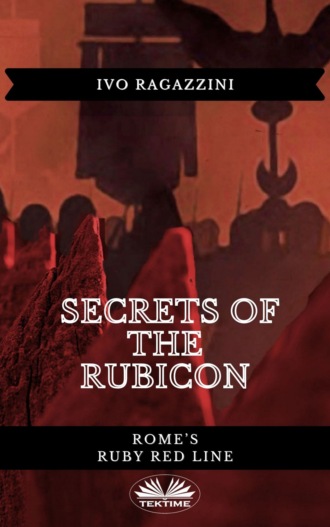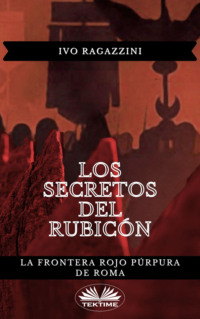
Полная версия
Secrets Of The Rubicon

Ivo Ragazzini
SECRETS OF THE RUBICON
Rome's Ruby Red Line
Original title: I Segreti del Rubicone
Translated by: Rosemary Dawn Allison
© "Secrets of the Rubicon"
© 2018 Ivo Ragazzini
First paperback edition November 2018 -- Montag Edizioni
Second paperback edition September 2020
First digital edition August 2019
Second digital edition September 2020
The Author reserves all rights, including reproduction and even partial translation into any other language. The reproduction and use of this work, even partial and by any means, be it graphic, electronic or mechanical, is not permitted without the Author's written authorization. The same does not authorize the modification, or translation into any other language, of one or more parts of this work. Any unauthorized use constitutes a violation of copyright.
For all requests please write to:
ragazzini.ivo@gmail.com
or contact the author at +39 3477496534.
No part of this book may be reproduced, translated, or stored in a retrieval system, or transmitted in any form or by any means, electronic, mechanical, photocopying, recording, or otherwise, without express written permission of the author.
For requests write to ragazzini.ivo@gmail.com or call the author +39 3477496534.
Contents
Contents
Preface
Where the Rubicon lay was also the road to Rome
What was the real Rubicon?
The conversation between Caesar and Hortensius continues
Brief historical introduction
Caesar's arrival in Cesena (Curve Caes Arena)
The Urgon witch
The disposition of Caesar and Pompey's troops
Mark Anthony, Hortensius and Caesar's plan
Caesar's political plan for Rome
Caesar climbs the Colle Garampo to observe Pompey's troops
Curva Caes Arena -- Caesar's circular arena
The Gallic legions arrive and begin to resettle the land in Romagna
La Caveja the symbol of Romagna
A Flamen comes to threaten Caesar telling him not to dare cross the Rubicon
The curse of the Rubicon
The conversation between Caesar and the Flamen
The Flamen curses the Rubicon border
Superstition makes Caesar free a few horses on the Rubicon to make them cross the forbidden border
The Urgon witch
What was happening beyond the Rubicon among Pompey's ranks?
The mysterious caves of Santarcangelo di Romagna
The Cult of Mithras
The elections for the Chief Consul of the Year in Rome
Caesar's secret plan
Arriving in Rome, Caesar's men set about seeking alliances to influence his election
The festivities for the Head of the Year -- The New Year
New Year on the Rubicon
Caesar secretly arranges the plan to attack the Rubicon
Caesar pulls back to Ravenna far from the Rubicon
The day before the attack on the Rubicon
The Rubicon Malanotte
Rubicon nightmares
Caesar crosses the Rubicon and takes Rimini by surprise
The Urgon Malanotte and the Caligaes cemetery
The Caligaes cemetery
Pompey's troops on the Rubicon surrender to Caesar
Caesar receives a message from the Flamen Jovis
Was there a small area of neutral land between the borders of Romagna and Rome?
Caesar's descent to Rome and the dire forewarnings of the population
Caesar's march through the Marche
The cults in the temples of the Marche
Caesar's conquest of Italy
Caesar's end
Biography of the author
By the same author: "The Ghost of Girolamo Riario"
By the same author: "Under the Green Branches - The Last Ghibellines"
Preface
Once upon a time, on the way to Rome, there was a land that was traversed and defended by the Romans as a sacred, impassable border.
That land was formerly called Flaminia, it was then renamed Romagna for reasons that you will soon discover for yourself.
Today that sacred and impenetrable border, protected by the Gods of Rome, is no longer, but it existed then and many events occurred around there.
At that time the Romans knew very well what that border was and why they had built it, but from the Middle Ages until today, no one knew where it really was and many have tried to find it.
But there was no unified search and three or four conflicting theories have arisen regarding its location.
But where did that border go? And mostly, what really happened there?
Today, and for centuries, many have continued to ask themselves this question. Occasionally various societies and academies have gathered together in argumentative meetings to decide, now in favor of one place, now in favor of another.
But to questions such as:
For who and why was that border built the first time?
Why and how was it built?
Why did the Romans call it Puniceus Rubicon?
Why were there red sands that no longer exist today?
Was there a place called 'Malanotte' (Dreadful night) on the banks of that border?
Did Caesar and many Roman legionaries have nightmares or a Malanotte before crossing that border?
It seems that no one has tried to answer these and many other questions.
And that is shame, because it would have led to discovering a few answers and much more about what the Rubicon was, and what it was for, which would have led to discovering why and who had built that border, plus many other novelties that you will discover for yourself while reading.
Briefly, we have been discussing and researching the location of the Rubicon for centuries, but before finding the location of this border, many failed to discover what it was for and who and why built it the first time before Caesar was even born.
And if anyone had investigated these things thoroughly, I am convinced they would inevitably have discovered this and more.
I only add that this book, is not a rehashing of other works, and will lead you to discover many other mysteries and stories about the history of Rome, the Rubicon and ancient Romagna for the first time that you may never have suspected.
Straddling somewhere between an essay and historical account, the way is opened through twenty centuries of history and paths that have never been travelled before. This book is based on historical research, forgotten local legends, etymological research and observations that have never been made before. For the first time, light is shed on the darkness of those disputed events on the ruby-red border named the Rubicon. A unique story has been created that refers to nothing that has been written previously on the subject.
In particular, this book will answer the following questions for the first time:
What really was the Rubicon?
Why was it given that name?
Who for and why was the border created long before Caesar?
What was Romagna at the time?
What were the symbols and insignia used by Caesar's Gallic legions?
What insults did the Roman legionaries and warriors of that time shout?
What was the New Year's feast at the time of Caesar?
Why did Caesar cross the Rubicon immediately after the New Year's elections?
And, to tell the truth, many other things that you may never have guessed at, in a crescendo of facts and revelations that will reveal many facts and places that have been forgotten by history during that turbulent period of transition from republic to the Roman Empire.
So, enjoy reading and rediscovering the history of the Rubicon as well as many other facts.
Where the Rubicon lay was also the road to Rome
Romagna towards the end of 50 BCE (before common era). Julius Caesar and his military escort turned away from Ravenna to travel to Cesena
"Ubi est Rubico finis, etiam est Roman Via" (Where there is the Rubicon border there is also the road to Rome), Caesar told the young escort commander Quintus Hortensius who was sitting next to him on a military chariot, when they travelled from Ravenna they crossed the road leading to Cesena, which was guarded by the Tenth1 legion. It was one of the places Caesar, already in debt for a sum of over one hundred million sesterces, was building in Romagna near the border called the Rubicon.
"Did you know that Hortensius?" added Caesar.
"I've never been there but once a centurion told me something like that," replied Commander Hortensius in Latin mixed with Gallic.
"Did he at least tell you who built it and why it was called Puniceus Rubicon2 ?" asked Caesar.
"No."
"Then that centurion didn't explain very much to you," smiled Caesar.
"Would you teach me, General Caesar?"
"Very well, Commander Hortensius."
"Many years ago, when there was no Romanavia3 , a tribune called Flaminius built a road that led from Rome to Rimini in this land that was named Flaminia in his honor."
"However, a few years later a Punic general named Hannibal crossed the Alps and surprised Rome from northern Italy."
"So the Tribune Flaminius was appointed Consul and the Senate quickly ordered him to defend the road to Rome, which he had just finished building, and to construct a defensive line to block access and prevent Hannibal descending towards Rome."
"And so, the consul Flaminius, built that series of lines of defenses on a few rivers and trenches between the current Caes Arena and Ariminium and called it Puniceus Rubico4 . These defenses were hurriedly constructed because he had to halt the Punic Hannibal's descent towards the Via Flaminia, the only road that led from the north directly to Rome," explained Caesar.
"Thank you Caesar. Why do they call it Rubico finis today?" asked Hortensius.
"Because it is a ruby-red line that is still impassable to enemies and protected by the Gods of Rome. These defenses were cordoned off by palisades made of maritime pines that were taken from the enormous pine forests you see around here. It was then painted rubico,5 the sacred color of Rome, and made inviolable by the Gods with a sacred ritual performed by a few Flaminian6 priests who placed the terrifying spirits of our Patres to guard the border and punish whoever dared to cross it armed."
"So, it was forbidden to cross the Rubicon armed for this reason?" asked Hortensius a little alarmed.
"Certainly, but I should add they also placed legionaries to guard it, because sometimes the gods alone are not enough. And seeing that now the Punic threat has disappeared, most people only call it the Rubicon and leave it standing to prevent any barbarians and enemies from the north descending towards Rome." Smiling Caesar added, "Including Roman and Gallic legionaries, of course."
"Therefore Rubicon means ruby-red, noble Caesar?"
"Of course, it is the sacred color of Rome, the ruby color that you still see on all our dispatches and red-bordered notes that we use and receive from Rome,"7 replied Caesar.
"Thank you Caesar, I didn't know. Could you also explain why the Roman legionaries are afraid to cross it, while those of Gallic origin are not?"
"Because whoever is Roman and crosses it becomes a traitor and, it is said, the Gods of Rome will strike them down with a bolt of lightening, while whoever is not Roman will be defeated by the soldiers of Rome helped by the Gods. Or at least so some Flaminia priests say, who every now and then perform a ritual to curse anyone who tries to cross it bearing arms," Caesar answered with a smile.
"With all these curses surrounding it, wouldn't you be afraid to cross it also, noble Caesar?"
After thinking a while Caesar replied: "A little, yes, but not much."
"So it is only because of the Flaminian priests' sacred protection that our Gallic legionaries would be willing to attack it, while the Roman legionaries would not," asked Hortensius, thoughtfully.
"Of course, the problem is not only military, but religious also," replied Caesar smiling.
"Is the Rubicon still defended by that red palisade?" asked Hortensius.
"Yes. Those ruby-red painted poles are occasionally restored and rededicated by a Flamen Dialis8 and must eternally protect and ensure people know where the Rome border is located, beyond which it is forbidden to march armed. Once Hannibal was defeated, that border was simply called Rubicon and now it has remained the border for entering and leaving the Roman territory," explained Caesar.
"I read a report that says: two legions under Pompey have left the Rubicon and lined up almost below Cesena," said Hortensius, increasingly curious to learn new things.
"Yes, but they haven't really left the Rubicon; they have arranged themselves on the three defensive lines that have always been the Rubicon since the time of Flaminius, when he tried to stop Hannibal between Rimini and Cesena."
A little surprised Hortensius asked, "The Rubicon has three defensive lines between Rimini and Cesena?"
"Of course, Commander Hortensius. The Rubicon was built on three defensive lines, spaced far enough apart from each other so that it was possible to maneuver between them without difficulty and thwart enemy attacks, as our Roman strategy for war should have taught you long ago," Caesar smiled slightly, who saw Hortensius as his young student.
"And which of the three lines would the Rubicon be?"
"They are all three defensive lines of the Rubicon, but only the final red line, the one just before Ariminium, built on the Pluso9 river is the one that is protected by a fence and made impassable to anyone coming armed against Rome," explained Caesar.
Hortensius was thoughtful for a moment and then added:
"What if we crossed it armed?"
"We will immediately be declared traitors and enemies of Rome."
"I understand. Why is that area called Romandia?" asked Hortensius, as tirelessly curious as he was.
"It is called Romandia, because it means crossing and the Roman district, in peacetime it is used to disband the legions before entering Rome or to rearrange and reorganize them to go north."
"Moreover, if you have read the latest military report, they are afraid we'll cross that line and they've hurriedly sent two Pompeian legions to the front line near Cesena to reinforce that area to prevent us from crossing," explained Caesar.
"Yes, I've read that report as well. It says the Pompeian legions have left the Rubicon and lined up on some well-defended rivers and trenches and are quite close to Cesena," replied Hortensius.
"Exactly, but I want you to look at the situation better," said Caesar as he pulled out a map of the place drawn on parchment that he opened in front of Hortensius.
"Pompey's legionaries camped, more or less here, near Caes Arena, as did the Consul Flaminius against Hannibal. And their first line was located on this river, which can be flooded by diverting the waters thanks to the locks and channels located upstream a few miles towards the mountains above Caes Arena," said Caesar while showing him the place on the map.
"And where is the Rubicon's second line?" asked Hortensius.
"It's here! A few miles back on another stream, at a place called Ad Confluentes, which can always be flooded by diverting the waters upstream," Caesar showed Hortensius where it was on the map.
"And where is the final line?"
"It is this red line you see drawn here, a few miles further south near Ariminium,10 where it is defended by a red wooden fence that stands as much as four meters tall for the reasons I've just told you. And this is the impassable border that, with or without the favor of the Gods, I intend to cross," concluded Caesar threateningly.
What was the real Rubicon?
You should have understood this already from the conversation between Caesar and Hortensius, but let's try to summarize what has happened over time.
For centuries historians have debated and puzzled about what the real Rubicon was because of the fact that according to historical sources, legends and geological reconstructions, it now seems to have been a river that passed near Cesena, now other rivers between Savignano and Santarcangelo di Romagna,11 which was true in a way, but a few details were lacking that created a little confusion.
The confusion was related to the fact that long before, at the time of the Consul Flaminius, the Romans had created a defense made up of three defensive lines arranged one behind the other, as instructed by the military technique of the time, to stop no one less than Hannibal12 who had crossed the Alps with his troops and some elephants and would descend towards Rome by way of the Via Flaminia. Its construction had been completed a few years before, and the people in the area had named it Roman-Dia and also Roman-Via, which meant, if you prefer, Roman Crossing or Way to Roma.
The names Romània, Romandiola and the current Romagna were derived from these terms.
The final defensive line of the Rubicon had been drawn almost entirely on the river that is known today as the Uso.
The other two lines of the Rubicon were: one on the Pressatellum river today called Pisciatello and the other on the river now called Fiumicino. And probably both, if not all three, were linked by canals and hydraulic locks to the mountain springs of the Urgon, another river whose name historians believe meant Rubicon in the Romagna dialect, but which in Etruscan meant something else, as you will read more about later.13
Several miles of that boundary on the Uso river were cordoned off by a row of tall wooden poles and boards held together by iron and metal brackets and, until 1750, remnants of those palisades still existed on the banks of the Uso river, so much so that the farmers there used to take them to make agricultural tools.
If you now think that such a work was too large or impossible for the Romans, you should know that Crassus, a contemporary triumvirate of Caesar, created a similar work around 70 BCE, which divided Calabria in two, from the Tyrrhenian to the Ionian coast, with a four meter high palisade, to isolate the revolt of Spartacus and his rebel gladiators who had taken refuge in Aspromonte.
Moreover, the Rubicon had stones and red cultured sand on the Uso river that no longer exist today, but had been in existence until the end of the 1700s, as the academic historians of the time reported and argued about for a long time, theorizing that the Romans had colored them red to make it clear that this was the Rubicon.
However, those were not really stones and sand that the Romans had purposely colored red, but the ruby-red pigment that had fallen to the ground once the color on the wooden palisade had been swept away little by little by rain and floods, as time passed and the wood of the palisade had rotted.
Furthermore, opening barriers and water channels upstream from the sources of the Urgon would have swelled the Rubicon; the steep banks14 were raised artificially to sink those attacking and attempting to cross it on foot or on horseback into the mire, not to mention Hannibal's elephants.
The land, where the Rubicon was located, was called Roman-dia, diameter, district or Roman area, since the land was used by the legions to cross or camp entire units of legionaries, before entering the Roman territory or to recompose new legions, including veterans and those waiting nearby to be enlisted before marching to the north and the Gauls.
Therefore, when someone says that Romagna has always been a happy and hospitable land full of festivals and entertainment, they are telling the truth, because it was true even then, as was all the land along the border, where the legionaries from various places set down their arms, collected their reward and devoted themselves to various festivities and leisure time, while waiting for new engagements and assignments.
And perhaps it is not even a coincidence that many German citizens and those from northern Europe have continued to come to Romagna for their holidays for centuries and consider it their second home, but there is more to be learned about this.
The conversation between Caesar and Hortensius continues
As they continued to travel across Romagna, Caesar told Hortensius: "You should know that what Pompey is doing with us now, Gaius Flaminius had also been deployed to the Puniceus Rubicon in defense formation when he was waiting for Hannibal's descent."
"And how did it end between Flaminius and Hannibal?" asked Hortensius.
"It ended badly. The tribune Flaminius was good as a builder and politician, but he was a little less so as a soldier. He first built the Via Flaminia and then, using the same military engineers, he made a splendid defensive line against Hannibal. But he made a careless strategic error and none of it ended well," said Caesar
"What mistake did he make?"
"When some of Hannibal's units arrived in advance in front of the Rubicon, they saw the well-organized and defended lines that blocked their way to the road to Rome. So they decided to avoid getting into an inconvenient fight and to pass through the Apennines, departing Cesena and going towards Sassinia and Balneum, then continuing to Arretium in the Tiber valley,15 while the bulk of Hannibal's army went through the mountains above Modena and re-joined the units in advance."
"And then?"
"Flaminius felt cheated and made the strategic miscalculation of leaving the Rubicon with his troops, and he began to chase Hannibal through the Apennines. It was an immense tactical error because Hannibal, having crossed the Alps, had a tactical superiority on those mountainous trails, while Flaminius's legions were trained and accustomed to garrison a place and to march and maneuver in compact formation on flat, wide planes," Caesar explained.
"And how did it end?" asked Hortensius.
"It ended extremely badly. Flaminius began to pursue Hannibal who drew him into a long and narrow gorge, where there were mountains on one side and Lake Trasimeno on the other, which prevented him from being able to manoeuver.
While Hannibal was pretending to escape, he made his cavalry climb into the mountains to wait for the Roman troops and so, when Flaminius arrived, he was surprised by Hannibal's cavalry, who first tumbled large boulders onto the Roman formation, broke it apart and then fell upon them on horseback, exploiting the strength and speed they could gain down the mountain slopes to subdue and overwhelm them."
"At the same time a part of Hannibal's army, which had pretended to escape, turned and went to meet the Roman army to finish them off in hand-to-hand combat. Thousands of Romans died including Flaminius," explained Caesar.
"How is it possible that Flaminius made such a tactical error?" asked Hortensius.
"I've no idea. It was probably the senate in Rome that became scared and ordered Flaminius to leave the Rubicon to join the legions under another consul, who was waiting for Hannibal outside Rome, and then attack Hannibal together in the open plain."







